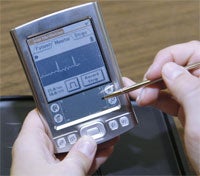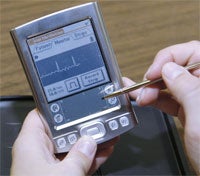 Students receive PDAs to assist with clinical, classroom work
Students receive PDAs to assist with clinical, classroom work
KINGSTON, R.I. — December 6, 2005 — It used to be that when nursing students had questions about their patients’ medications and illnesses, they had to leave the bedside and consult large and often outdated reference texts. This practice was both inconvenient and time consuming.
Today, thanks to a partnership between the University of Rhode Island Office of Information and Instructional Technology Services and the URI College of Nursing, a pilot group of nursing students have the opportunity to find health care information quickly and efficiently at the patient’s bedside using a personal digital assistant (PDA).
Earlier this fall, 100 Palm Tungsten E2 PDAs were purchased — 50 for nursing students and 50 for nursing faculty. Graduate students in Professor Laurie Lauzon Clabo’s Clinical Nurse Leadership program, and undergraduate students in Professor Mary Leveillee’s Psychiatric-Mental Health and Nursing in Childbearing-Reproductive Health courses were selected for the pilot project. The PDAs are on loan to the students for the academic year. They will be allowed to keep them as long as they pass their classes and write an evaluation about how they used them.
The students installed a software program called Epocrates on their PDAs, which helps them learn about drug dosing and costs. Epocrates also can store drug databases, medical references and appointments, and it has a tool to make a variety of calculations like intravenous drip rates. Because the nursing students can easily carry this information on the Palm, they no longer need to leave the patient’s bedside to consult textbooks and references when questions arise. “It’s important for students to have ready access to important information in the clinical setting,” said Leveillee.
In addition, the databases and reference guides are easily updated on a regular basis by synchronizing the Palm to the student’s own computer, ensuring the student has the most up-to-date information available. During the weekly updates, new health care alerts, scholarly articles, and updated diagnostic information are sent to the PDAs. “We want to make students aware that knowledge isn’t static,” said Lauzon Clabo.
The students in the pilot program are pleased with the advantages of using the Palm in the clinical setting. “I don’t have to leave the patient to look for the cost of medications or to cross-reference drug interactions. I can tell them at the bedside,” said Jessica Doyle, a junior from Newport. “And it’s great for looking up diagnoses, treatments, and signs and symptoms.”
“It’s invaluable to be able to calculate drip rates and algorithms so quickly,” said Lisa Dussinger, a registered nurse from Woonsocket and graduate student in Lauzon Clabo’s class.
“The biggest constraint on nurses is time. There’s just not enough time to do everything we need to do,” said graduate student Patricia Carlton of Smithfield, a registered nurse at Miriam Hospital. “The PDA saves us a lot of time running around looking for answers.”
Luz Marquez-Mocarsky, a graduate student and registered nurse at Roger Williams Medical Center, is pleased to see technology that is already used in the workforce integrated into the classroom. “It’s the most wonderful thing for educating patients,” said the Cumberland resident. “It impresses them. They like to read and see what you’re looking up.”
Next year, all nursing students will be required to purchase a PDA. “We know that this is an added expense, but we feel that students will use the PDA’s in all of their clinical courses and graduate knowing that this is a necessary tool for all registered nurses,” said Dayle Joseph, dean of the URI College of Nursing. A Palm Tungsten E2 sells for about $200.
“It’s expensive, but it will definitely be helpful down the road,” said Marquez- Mocarsky. “It’s the best investment ever.”

